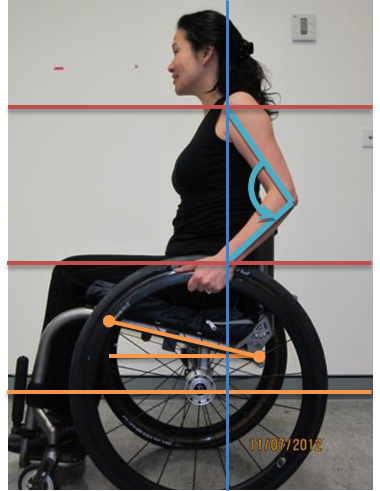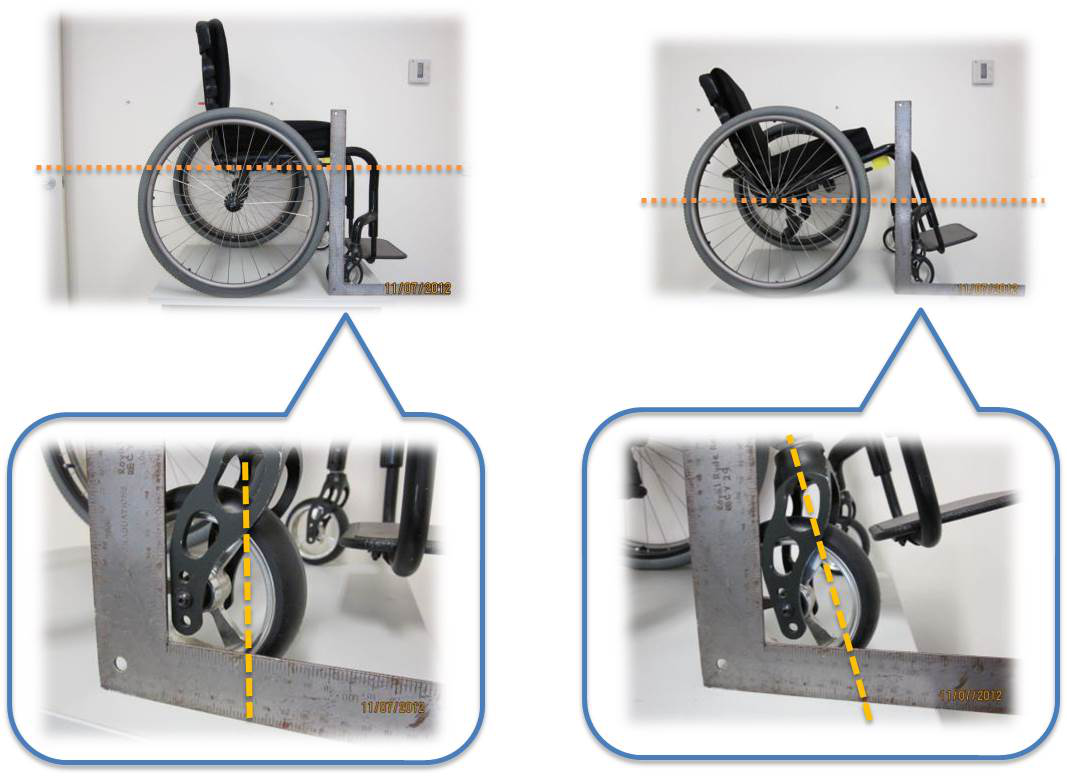Spinal Seating Modules
Wheelchair configuration for optimal propulsion
For propulsive efficiency and preservation of upper limb function there is an optimum position for the client in relation to the rear wheel. If the client is too high above the rear wheel, the length of push stroke is reduced which requires an increased frequency of pushing, and increased risk of wear in the upper limb joints. If the client sits too low there is excessive shoulder abduction, internal rotation and elevation to move through the push phase, and this repetitive movement increases the risk of shoulder pain. The PVA recommends positioning the rear wheel such that the forearm-upper arm angle is 100-120°.
- PVA Recommendation #9:
- Position the rear axle so that when the hand is placed at the top dead-centre position on the pushrim, the angle between the upper arm and forearm is between 100° and 120°.

Figure 3: Seating position and forearm-upper arm angle.
Changes in the angle between the upper arm and forearm are influenced by:
A. A change in the rear seat-to-floor height
The rear seat to floor height is adjusted by raising or lowering the axle receiver on the wheelchair frame. Raising the receiver lowers the seat, and vice versa. On most wheelchairs this adjustment alters the tilt angle of the seat (‘seat rake’), the backrest recline angle and the angle of the castor stems. So changing the rear seat to floor height usually requires the backrest recline angle and castor stem angles to be corrected. When correctly adjusted the castor stem should be perpendicular to the ground.

Figure 4: Adjusting rear seat-to-floor height affects the front castor angle. These must be also be adjusted to compensate.
B. A change in the horizontal position of the axle
Moving the axle horizontally alters the amount of shoulder extension required to perform propulsion stroke. Moving the axle rearwards increase the angle of shoulder extension and increases the radial deviation of the wrists when grasping the handrim, as well as reducing the length of the push stroke. This would affect shoulder alignment over the axle. An axle located behind the shoulder position would require a greater angle of shoulder extension to reach the rear wheel and place the wrists in a greater radial deviated position. It would also reduce the push phase per stroke as the rear wheel is further behind and the upper and forearm angle will reduce when it is at top position of push rim.
C. A change in posture
A slumped posture lowers the shoulder height and reduces the angle between the upper arm and the forearm.
D. A change in cushion
A change in cushion height alters the shoulder height in relation to the wheel.
E. Achange in rear wheel size
In some cases it is necessary to choose a rear wheel larger or smaller in diameter than the normal size (600mm / 24 inches) to achieve a suitable configuration for optimal propulsion. (Note: Be aware that large diameter rear wheels may impede side transfers).
References
- Babinec, M. 25 Configuration choices for efficient wheelchair propulsion [Internet]. Invacare; no date. [cited Oct 2015] Available from: https://www.scribd.com/document/147400440/25-Configuration-Choices-for-Efficient-Wheelchair-Propulsion
- Sprigle, S & Huang M. The Impact of Manual Wheelchair Design & Configuration on Propulsion Torque. Assistive Technology ; 2015. https://pubmed.ncbi.nlm.nih.gov/26691562/
- Requeio, P.S., Furumasu, J., & Mulroy, S.J., 2015. Evidence-Based Strategies for Preserving Mobility for Elderly and Aging Manual Wheelchair Users [Internet]. Topics in Geriatric Rehabilitation: 2015 [12 Oct, 2015]: 31;1 : 26-41. Available from: https://www.researchgate.net/publication/271726655_Evidence-Based_Strategies_for_Preserving_Mobility_for_Elderly_and_Aging_Manual_Wheelchair_Users.
DOI: 10.1097/TGR.000000000000004